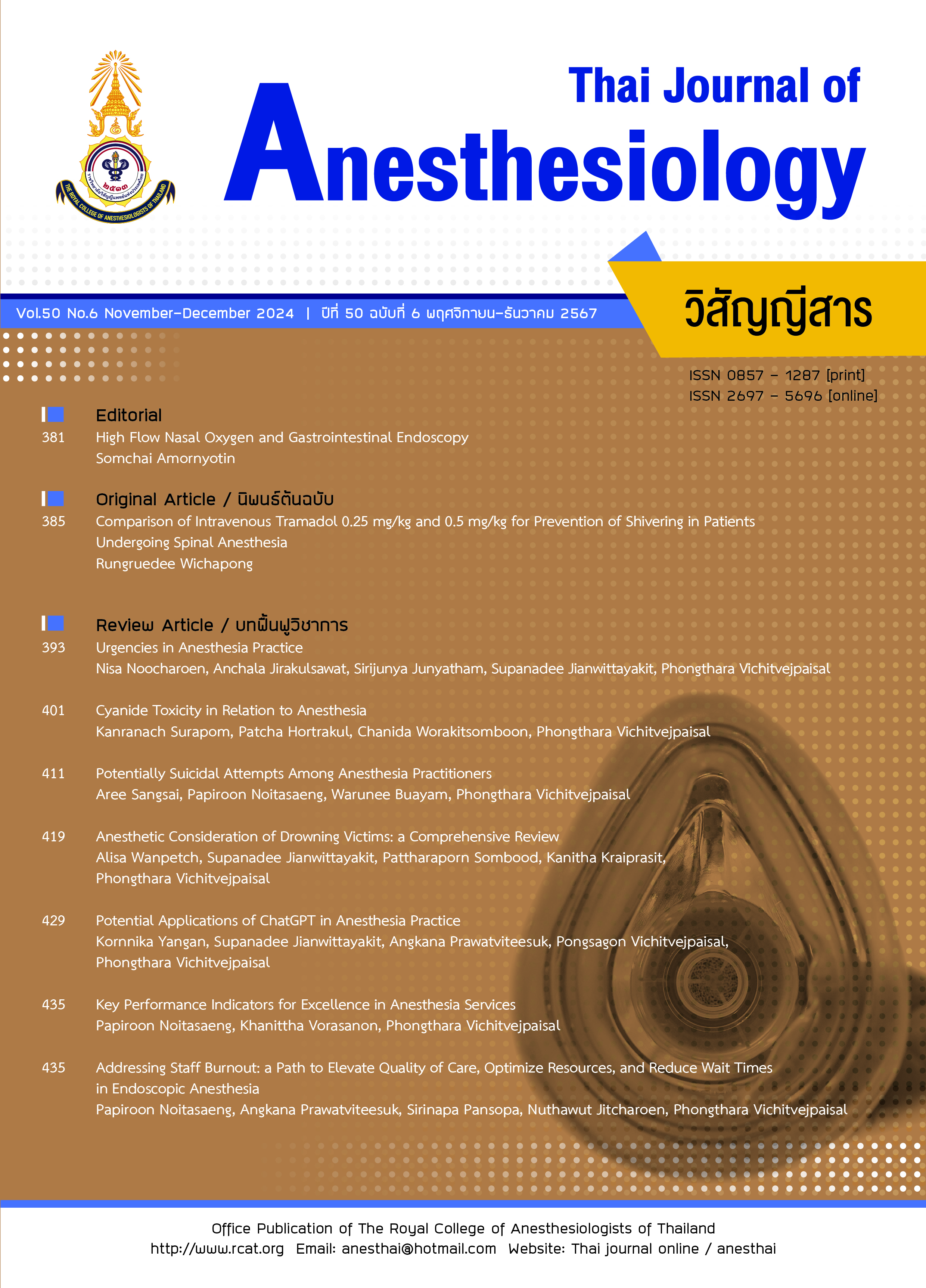Anesthetic Consideration of Drowning Victims: a Comprehensive Review
Main Article Content
บทคัดย่อ
Drowning incidents pose critical challenges in the healthcare landscape, necessitating swift and coordinated responses for successful resuscitation and management. This comprehensive review delves into the pivotal role of anesthesia practitioners within the trauma unit in optimizing care for drowning victims. It explores various facets of the care continuum, from prehospital and early hospital management to surgical interventions and postoperative care. Key takeaways include the time-sensitive nature of drowning emergencies, the unique considerations for pediatric victims, and the importance of effective communication and collaboration within the multidisciplinary trauma team. Anesthesia practitioners extend to addressing the complex challenges and potential complications associated with drowning incidents, such as delayed presentation, pulmonary and cardiovascular complications, and neurological impairment. Understanding anesthesia considerations in the context of drowning incidents is emphasized as crucial for enhancing patient outcomes and reducing the burden of these life-threatening events.
Article Details

อนุญาตภายใต้เงื่อนไข Creative Commons Attribution-NonCommercial-NoDerivatives 4.0 International License.
เอกสารอ้างอิง
World Health Organization. Drowning. Who.int. World Health Organization: WHO; 2021. Available from: https://www.who.int/news-room/fact-sheets/detail/drowning
Hwang V, Shofer FS, Durbin DR, Baren JM. Prevalence of traumatic injuries in drowning and near drowning in children and adolescents. Arch Pediatr Adolesc Med. 2003;157:50-3.
Olshaker JS. Submersion. Emerg Med Clin North Am. 2004;22:357-67.
Sindall R, Mecrow T, Queiroga AC, Boyer C, Koon W, Peden AE. Drowning risk and climate change: a state-of-the-art review. Inj Prev. 2022;28:185-91.
Szpilman D, Morgan P. Management for the drowning patient. Chest. 2020;159:1473-83.
Carter E, Sinclair R. Drowning. Cont Educ Anaesth Crit Care Pain. 2011;11:210–3.
DeNicola LK, Falk JL, Swanson ME, Gayle MO, Kissoon N. Submersion injuries in children and adults. Crit Care Clin. 1997;13:477-502.
Lumb AB, Thomas CB. Nunn and Lumb’s applied respiratory physiology, 2nd ed., Vol. 19, Edinburgh: Elsevier Ltd; 2021.
Parenteau M, Stockinger Z, Hughes S, et al. Drowning management. Mil Med. 2018;183(Suppl2):172-9.
Heikal S, Berry C. Management of drowning. Update Anaesth. 2011;28:141-4.
Razavizadeh MR. Role of anesthesia team in prehospital care: the hidden treasure in critical settings. Arch Trauma Res. 2015;4:e29422.
Nasr NF, Al-Jindi PC, Nasr IF. Rapid Sequence Intubation, 3rd ed., Reichman EF, ed. Access Medicine. New York, NY: McGraw-Hill Education; 2018 [cited 2024 Jan 7]. Available from: https://accessemergencymedicine.mhmedical.com/content.aspx?bookid=2498§ionid=201305594.
Restrepo CS, Ortiz C, Singh AK, Sannananja B. Near-drowning: epidemiology, pathophysiology and imaging findings. J Trauma Care. 2017;3:1026.
Van de Voorde P, Turner NM, Djakow J, et al. European Resuscitation Council Guidelines 2021: Paediatric Life Support. Resuscitation. 2021;161:327-87.
Pellegrino F, Raffaldi I, Rossi R, et al. Epidemiology, clinical aspects, and management of pediatric drowning. Ital J Pediatr. 2023;49:74.
Batista LL, Takita SY, da Silva Oliveira CM, et al. Drowning in pediatrics: literature review. Resid Pediátr. 2022;13:1-9.
Kinder Ross A. Pediatric trauma: anesthesia management. Anesthesiol Clin North Am. 2001;19:309-37.
Alderman EM, Ananthakrishnan AN, Baron TH, et al. Clinical overview drowning. www-clinicalkey-com. Elsevier BV. 2022 [cited 2023 Oct 14]. Available from: https://www-clinicalkey-com.ejournal.mahidol.ac.th/
Szpilman D, Bierens JJLM, Handley AJ, Orlowski JP. Drowning. N Engl J Med. 2012;366:2102-10.
Son KL, Hwang SK, Choi HJ. Clinical features and prognostic factors in drowning children: a regional experience. Korean J Pediatr. 2016;59:212-7.


